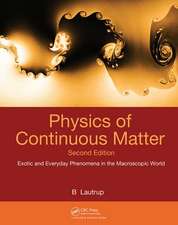Mechanics
Autor W. Chesteren Limba Engleză Paperback – 31 dec 1979
Preț: 397.01 lei
Nou
Puncte Express: 596
Preț estimativ în valută:
75.96€ • 79.32$ • 62.73£
75.96€ • 79.32$ • 62.73£
Carte tipărită la comandă
Livrare economică 15-29 aprilie
Preluare comenzi: 021 569.72.76
Specificații
ISBN-13: 9780412439407
ISBN-10: 0412439409
Pagini: 400
Ilustrații: 400 p.
Dimensiuni: 155 x 235 x 23 mm
Greutate: 0.63 kg
Ediția:1979
Editura: SPRINGER NETHERLANDS
Colecția Springer
Locul publicării:Dordrecht, Netherlands
ISBN-10: 0412439409
Pagini: 400
Ilustrații: 400 p.
Dimensiuni: 155 x 235 x 23 mm
Greutate: 0.63 kg
Ediția:1979
Editura: SPRINGER NETHERLANDS
Colecția Springer
Locul publicării:Dordrecht, Netherlands
Public țintă
ResearchCuprins
1. Vectors.- 1.1 Introduction.- 1.2 Definitions.- 1.3 The Rules of Vector Algebra.- 1.4 The Resolution of a Vector.- 1.5 The Products of Vectors.- 1.6 The Derivative of a Vector.- 1.7 The Integral of a Vector.- 1.8 Scalar and Vector Fields.- 1.9 Line Integrals.- 1.10 The Gradient Operator.- 1.11 Equipotentials and Field Lines.- Exercises.- 2. Kinematics.- 2.1 Introduction.- 2.2 Velocity and Acceleration.- 2.3 Constant Acceleration.- 2.4 Projectiles.- 2.5 Dimensions.- Exercises.- 3. Dynamics.- 3.1 Newton’s Laws.- 3.2 Units.- 3.3 Applications.- Exercises.- 4. Resisting Forces.- 4.1 Solid Friction.- 4.2 Motion through a Fluid.- Exercises.- 5. Impulse, Momentum, Work and Energy.- 5.1 Impulse and Momentum.- 5.2 Work and Energy.- 5.3 Potential Energy.- 5.4 Power.- Exercises.- 6. Oscillations.- 6.1 Simple Harmonic Oscillations.- 6.2 Damped Oscillations.- 6.3 Forced Oscillations.- 6.4 Coupled Oscillations.- 6.5 Non-Linear Oscillations.- Exercises.- 7. Central Forces.- 7.1 Basic Equations.- 7.2 Conservative Forces.- 7.3 Circular Orbits and Stability.- 7.4 Elliptic Harmonic Motion.- 7.5 The Inverse Square Law.- 7.6 Kepler’s Laws.- 7.7 The Effect of Resistance.- Exercises.- 8. Systems of Particles.- 8.1 Mass Centre.- 8.2 Equations of Motion.- 8.3 Collision Problems.- 8.4 Variable Mass Problems.- Exercises.- 9. Angular Vectors.- 9.1 Existence.- 9.2 Angular Velocity.- 9.3 Relative Angular Velocity.- 9.4 Rotating Axes.- 9.5 Axes on the Earth’s Surface.- Exercises.- 10. Moments.- 10.1 First Moment.- 10.2 Second Moment.- 10.3 Vector Moment.- 10.4 Parallel Vectors.- 10.5 Reduction of a System of Line Vectors.- 10.6 Work of a System of Line Vectors.- Exercises.- 11. Rigid Bodies.- 11.1 Equations of Motion.- 11.2 Impulse and Momentum.- 11.3 Work and Energy.- 11.4 Oscillations.- 11.5Three-Dimensional Problems.- 11.6 Gyroscopic Problems.- Exercises.- 12. Virtual Work and Lagrange’s Equations.- 12.1 Virtual Work.- 12.2 Generalised Coordinates.- 12.3 Lagrange’s Equations.- 12.4 The Lagrangian and Hamiltonian.- Exercises.- 13. Non-Linear Problems.- 13.1 Conservative Forces.- 13.2 Autonomous Forces.- 13.3 The Method of Averaging.- 13.4 Forced Non-Linear Oscillations.- Exercises.
















